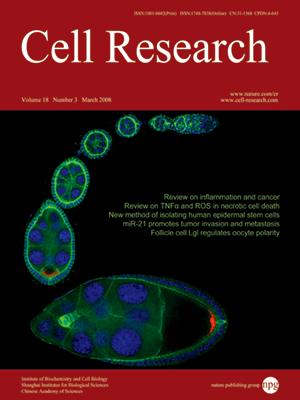
Volume 18, No 3, Mar 2008
ISSN: 1001-0602
EISSN: 1748-7838 2018
impact factor 17.848*
(Clarivate Analytics, 2019)
Volume 18 Issue 3, March 2008: 385-397
ORIGINAL ARTICLES
FIT interacts with AtbHLH38 and AtbHLH39 in regulating iron uptake gene expression for iron homeostasis in Arabidopsis
Youxi Yuan1,2,*, Huilan Wu1,*, Ning Wang1,2, Jie Li1, Weina Zhao1,2, Juan Du1,2, Daowen Wang1 and Hong-Qing Ling1
1The State Key Laboratory of Plant Cell and Chromosome Engineering, National Center for Plant Gene Research, Institute of Genetics and Developmental Biology, Chinese Academy of Sciences, Datun Road, Chaoyang District, Beijing 100101, China
2Graduate School of the Chinese Academy of Sciences, Yuquan Road, Shijingshan District, Beijing 100049, China
Correspondence: Hong-Qing Ling(hqling@genetics.ac.cn)
Iron is an essential element for plant growth and development. Iron homeostasis in plants is tightly regulated at both transcriptional and posttranscriptional level. Several bHLH transcription factors involved in iron homeostasis have been identified recently. However, their regulatory mechanisms remain unknown. In this work, we demonstrate that the transcription factor FIT interacted with AtbHLH38 and AtbHLH39 and directly conferred the expression regulation of iron uptake genes for iron homeostasis in Arabidopsis. Yeast two-hybrid analysis and transient expression in Arabidopsis protoplasts showed that AtbHLH38 or AtbHLH39 interacted with FIT, a central transcription factor involved in iron homeostasis in Arabidopsis. Expression of FIT/AtbHLH38 or FIT/AtbHLH39 in yeast cells activated GUS expression driven by ferric chelate reductase (FRO2) and ferrous transporter (IRT1) promoters. Overexpression of FIT with either AtbHLH38 or AtbHLH39 in plants converted the expression of the iron uptake genes FRO2 and IRT1 from induced to constitutive. Further analysis revealed that FRO2 and IRT1 were not regulated at the posttranscriptional level in these plants because IRT1 protein accumulation and high ferric chelate reductase activity were detected in the overexpression plants under both iron deficiency and iron sufficiency. The double overexpression plants accumulated more iron in their shoots than wild type or the plants overexpressing either AtbHLH38, AtbHLH39 or FIT. Our data support that ferric-chelate reductase FRO2 and ferrous-transporter IRT1 are the targets of the three transcription factors and the transcription of FRO2 and IRT1 is directly regulated by a complex of FIT/AtbHLH38 or FIT/AtbHLH39.
Cell Research (2008) 18:385-397. doi: 10.1038/cr.2008.26; published online 12 February 2008
FULL TEXT | PDF
Browse 2029


